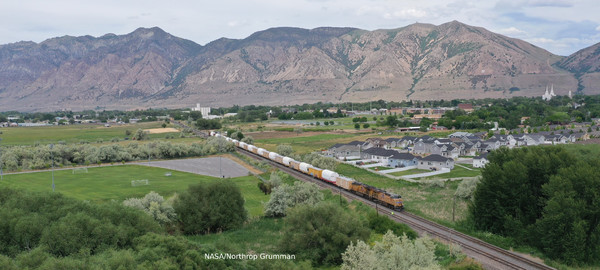Dublin Core
Title
Description
In 1956, with the Cold War in full swing, aerospace companies were eager to earn lucrative government contracts building solid-fuel rocket motors. When Thiokol -- a company now known as Northrop Grumman -- pursued a government contract for the Minuteman missile program in Brigham City, this small town in northern Utah was forever changed from an "isolated, sheep-and-sugar-beet town into a booming center of US rocketry." Thiokol's decision to build facilities near Brigham City spurred rapid change that profoundly impacted the local economy, culture, and environment.
Thiokol had many requirements for a new rocket plant, starting with 2,500 acres of affordable land, nearby transportation, a town for workers, and remote enough so that rocket tests wouldn’t endanger the neighbors. Thiokol purchased 10,000 acres in Promontory -- about 30 miles west of Brigham City -- and opened its plant of fifteen buildings in October 1957. It was soon awarded a contract with the US Air Force to develop the first stage of Minuteman nuclear missiles.
Thiokol sold Brigham City to potential employees by highlighting outdoor activities and the town’s proximity to Yellowstone National Park. Seemingly overnight, engineers and scientists, along with their families, arrived to make Brigham City their home. Schools and religious spaces saw attendance increase and diverse houses of worship were established for incoming workers, including Lutheran, Catholic, Buddhist, and Jewish residents. Within a decade the town doubled in size to nearly 12,000 people.
The first ten years of Thiokol's operation pumped an average of three million dollars a month into the local economy. Once Brigham City had a taste of what industry could bring, they were hooked. When budget cuts reduced Thiokol's workforce in 1967, the city mayor made it his mission to attract more companies to set up shop in the area.
But, not everyone benefited from Thiokol’s arrival. Tensions over land use between the plant and ranchers developed when the local Connor Cattle Company sued Thiokol for causing their livestock to get sick and die. Local businesses also struggled to keep their employees because of Thiokol’s competitive wages. From the moment Promontory was chosen, Brigham City was on a new journey, as Thiokol linked this small rural community to the national defense and space industry.
Creator
Source
_______________
See Brigham City Museum, exhibition file for Rural to Rockets: Brigham City Takes Off, curated by Jennifer Hill, 2024; Eric G. Sweden, “Thiokol in Utah,” Utah Historical Quarterly, vol. 75 (no. 1), 2007.

